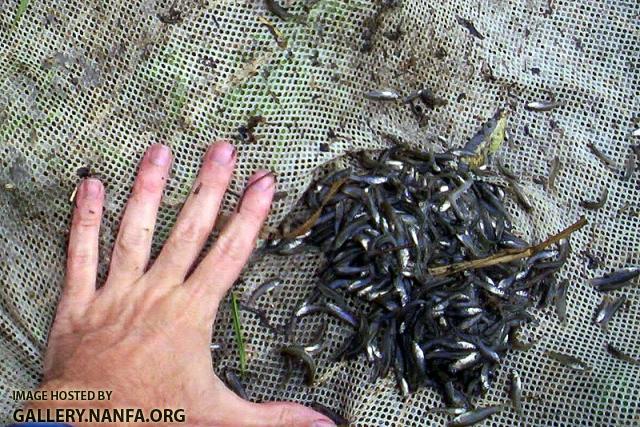Mosquitofish in NE Ohio...
#1
 Guest_andyavram_*
Guest_andyavram_*
Posted 26 August 2008 - 08:16 AM
He then informed me that these fish won't do any harm, and maybe they won't spread due to our harsh winters, but what do you think? I have heard Mosquitofish can harm tadpole populations but what are some other impacts they may have?
Andy
#2
 Guest_fundulus_*
Guest_fundulus_*
Posted 26 August 2008 - 09:34 AM
#3
 Guest_farmertodd_*
Guest_farmertodd_*
Posted 26 August 2008 - 09:59 AM
Now, I'm not saying go introduce them... I wish they'd make it illegal to sell them for ornamental ponds, which is probably how your population became established. But I would agree with your surveyor's assessment.
Todd
#4
 Guest_butch_*
Guest_butch_*
Posted 26 August 2008 - 12:10 PM
#5
 Guest_uniseine_*
Guest_uniseine_*
Posted 26 August 2008 - 12:24 PM
Near the Ak Sar Ben Aquarium, near South Bend, NE, I caught some Dambusia. I set my 4 foot seine across a 1.5 foot wide by 1 foot deep creek mouth just before the creek joined the Platte River. I kicked down 20 feet of the creek and lifted my seine. This is what I caught:

#6
 Guest_fundulus_*
Guest_fundulus_*
Posted 26 August 2008 - 02:17 PM
#7
 Guest_bflowers_*
Guest_bflowers_*
Posted 27 August 2008 - 04:55 AM
Thanks, Phil, I rest my case.
About a year ago Pat Rake's of Conservation fisheries did a talk on the Barrens Topminnow. Pat actually used the Barren's Topminnow as his Thesis at the University of Tennessee. During the talk Pat explained what they went through to find out why the Barren's Topminnow population was declining. They finally figured out that the Gambusia was out competing the Topminnow. One of the things he pointed out in the talk was that the Gambusia would persistently attack the larger topminnows. Once they started removing the Gambusia, the topminnow started to make a come back. Below is a link to the website and a short summary of what he learned.
http://www.conservat...lus_julisia.htm
Bill F.
#8
 Guest_uniseine_*
Guest_uniseine_*
Posted 27 August 2008 - 11:26 AM
About a year ago Pat Rake's of Conservation fisheries did a talk on the Barrens Topminnow. Pat actually used the Barren's Topminnow as his Thesis at the University of Tennessee. During the talk Pat explained what they went through to find out why the Barren's Topminnow population was declining. They finally figured out that the Gambusia was out competing the Topminnow. One of the things he pointed out in the talk was that the Gambusia would persistently attack the larger topminnows. Once they started removing the Gambusia, the topminnow started to make a come back. Below is a link to the website and a short summary of what he learned.
Bill F.
I heard that Fundulus sciadicus, Plains Topminnow, is currently in rapid decline in Nebraska.
I couldn't find any articles more recent than 1997.
#9
 Guest_farmertodd_*
Guest_farmertodd_*
Posted 28 August 2008 - 11:59 AM
I heard that Fundulus sciadicus, Plains Topminnow, is currently in rapid decline in Nebraska.
You guys are overlooking just a couple covariate factors out in Neb
Todd
#10
 Guest_uniseine_*
Guest_uniseine_*
Posted 28 August 2008 - 01:25 PM
You guys are overlooking just a couple covariate factors out in Neb

Todd
Ahh, the dilemma of a conservationist: If you wait for solid science, it may be too late.
Think about how long it took to Prove that cigarettes cause cancer.
#11
 Guest_andyavram_*
Guest_andyavram_*
Posted 28 August 2008 - 01:34 PM
Andy
#12
 Guest_farmertodd_*
Guest_farmertodd_*
Posted 29 August 2008 - 10:28 AM
Todd
Edited by farmertodd, 29 August 2008 - 10:29 AM.
#13
 Guest_ashtonmj_*
Guest_ashtonmj_*
Posted 29 August 2008 - 12:00 PM
About a year ago Pat Rake's of Conservation fisheries did a talk on the Barrens Topminnow. Pat actually used the Barren's Topminnow as his Thesis at the University of Tennessee. During the talk Pat explained what they went through to find out why the Barren's Topminnow population was declining. They finally figured out that the Gambusia was out competing the Topminnow. One of the things he pointed out in the talk was that the Gambusia would persistently attack the larger topminnows. Once they started removing the Gambusia, the topminnow started to make a come back. Below is a link to the website and a short summary of what he learned.
http://www.conservat...lus_julisia.htm
Bill F.
Actually, most of the field and laboratory research done showing the competitive relationship between mosquito fish and BTM was conducted by students at Tennessee Tech. Pat and CFI have been involved to varying extents with this research. I'm also not quite sure the removal of the mosquitofish, via antimyacin?, was successful in the long run.
See Laha & Mattingly 2006a, 2006b, Johnson & Bettoli 2003, Goldsworth & Bettoli 2006, and upcoming manuscripts by Westhoff & Mattingly and Benton & Mattingly. Some project reports can also be found online.
0 user(s) are reading this topic
0 members, 0 guests, 0 anonymous users







